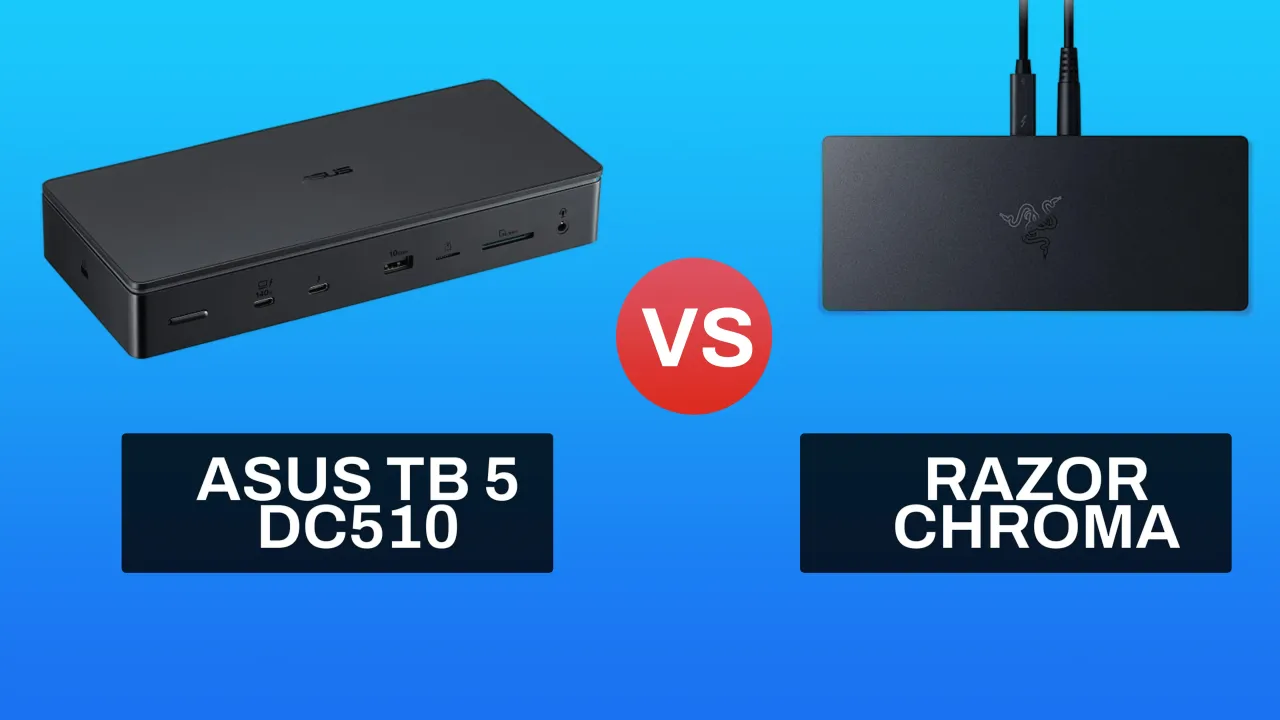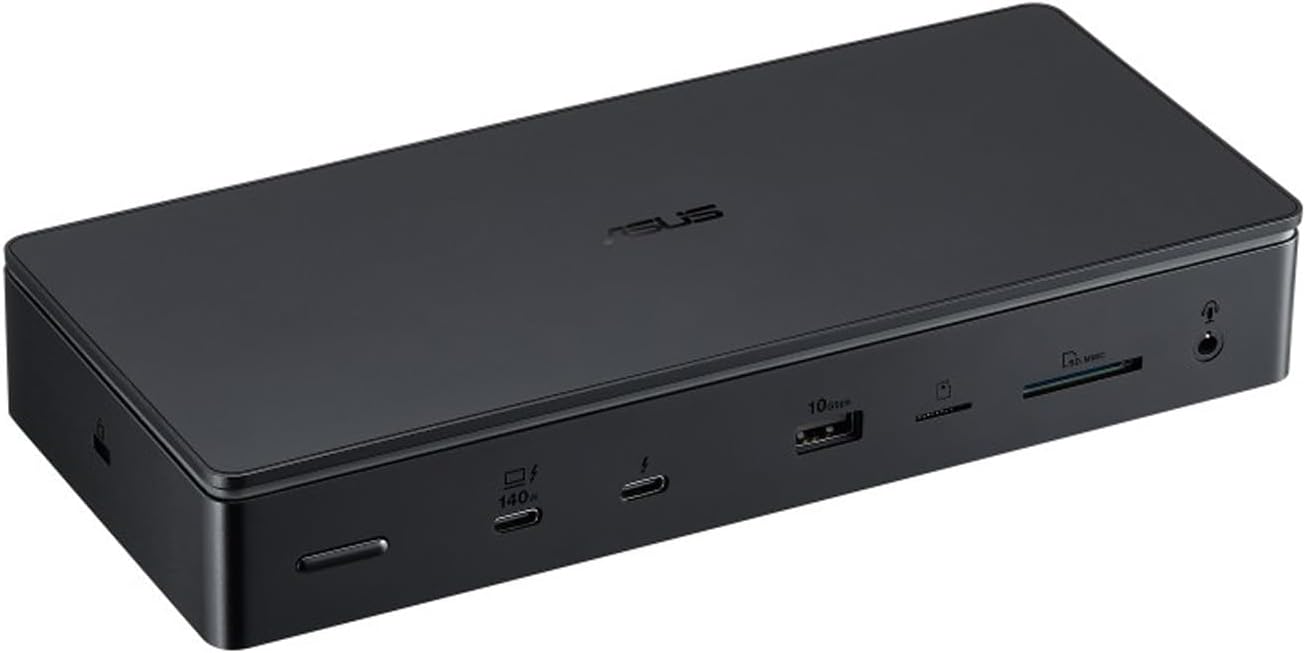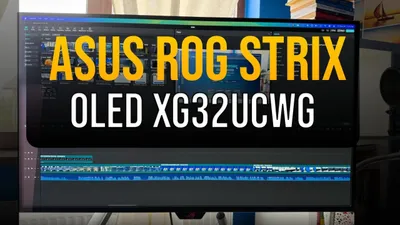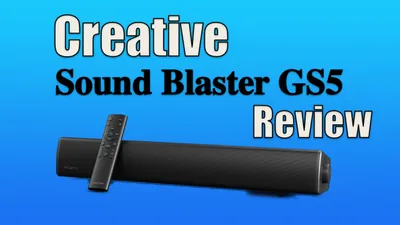ASUS DC510 vs Razer Thunderbolt 5 Dock Chroma: Which Should You Buy?
Detailed comparison of ASUS Master Thunderbolt 5 Dock DC510 and Razer Thunderbolt 5 Dock Chroma, including specs, ports, performance, and value analysis to help you choose the right dock.

Choosing between the ASUS Master Thunderbolt 5 Dock DC510 and the Razer Thunderbolt 5 Dock Chroma can be challenging—both are premium Thunderbolt 5 docking stations with excellent features. However, they cater to slightly different audiences and priorities.
After testing the ASUS DC510 extensively and analyzing the Razer Chroma’s specifications, I’ve created this comprehensive comparison to help you decide which dock best fits your needs, whether you’re a content creator, developer, gamer, or professional user.
Quick Recommendation
ASUS DC510 wins for professionals needing faster Ethernet (2.5GbE) and more USB-A ports. Razer Chroma is ideal for gamers who want customizable RGB lighting and Razer ecosystem integration.
Quick Comparison Table
| Feature | ASUS DC510 | Razer Chroma | Winner |
|---|---|---|---|
| Price | ~€420 / $460 | ~$400-450 | 🟰 Tie |
| Total Ports | 13 ports | 11 ports | ✅ ASUS |
| Thunderbolt 5 | 3 ports | 3 ports | 🟰 Tie |
| USB-A Ports | 4 ports | 2 ports | ✅ ASUS |
| USB-C Ports | - | 1 port (10Gbps) | ✅ Razer |
| Ethernet | 2.5 GbE | 1 GbE | ✅ ASUS |
| SD Card | SD + microSD | SD only | ✅ ASUS |
| M.2 SSD Slot | Yes (PCIe 4.0) | Yes (PCIe Gen4x4) | 🟰 Tie |
| Max SSD Size | 2TB tested | Up to 8TB | ✅ Razer |
| Display Support | 3x 4K @144Hz | 3x 4K @144Hz | 🟰 Tie |
| Power Delivery | 140W | 140W | 🟰 Tie |
| Power Adapter | 180W | 250W | ✅ Razer |
| RGB Lighting | Ambient LED | Razer Chroma | ✅ Razer |
| Audio | 3.5mm combo | 3.5mm (7.1 support) | ✅ Razer |
| Dimensions | 220x96.7x38mm | Slightly larger | ✅ ASUS |
| Weight | 765g | ~800g | ✅ ASUS |
| Cooling | Active (loud) | Active | 🟰 Tie |
| TB5 Cable | Yes (100cm) | Yes | 🟰 Tie |
| Best For | Professionals | Gamers | - |
Detailed Feature Comparison
Connectivity: Ports and Expansion
Front Panel:
- 1x USB-A 3.0 (5Gbps)
- 1x SD card reader (UHS-II)
- 1x microSD card reader (UHS-II)
- 1x Audio combo jack
Rear Panel:
- 3x Thunderbolt 5 (80Gbps each)
- 3x USB-A 3.2 Gen 2 (10Gbps)
- 1x 2.5 Gigabit Ethernet
- 1x M.2 NVMe PCIe 4.0 slot
- 1x DC power input
- 1x Kensington lock
Total: 13 ports + M.2 slot
Front Panel:
- 1x UHS-II SD Card Slot
- 1x Microphone/Headphone Combo Port (7.1 Surround)
- 1x M.2 Slot (PCIe Gen4x4)
Rear Panel:
- 3x Thunderbolt 5 (1 upstream, 2 downstream)
- 2x USB-A 3.2 Gen 2 (10Gb/s)
- 1x USB-C 3.2 Gen 2 (10Gb/s)
- 1x 1 Gigabit Ethernet (RJ45)
- 1x 250W Power Port
Total: 11 ports + M.2 slot
Winner: ASUS DC510
The ASUS offers more total ports (13 vs 11) and includes both SD and microSD readers, making it more versatile for photographers and content creators.
Network Performance: 2.5GbE vs 1GbE
| Specification | ASUS DC510 | Razer Chroma |
|---|---|---|
| Ethernet Speed | 2.5 Gigabit | 1 Gigabit |
| Max Throughput | 2,500 Mbps | 1,000 Mbps |
| File Transfer (1GB) | ~3.2 seconds | ~8 seconds |
| Best For | Large file transfers | Standard networking |
Network Speed Advantage
The ASUS DC510’s 2.5GbE provides 2.5x faster network speeds than Razer’s 1GbE. This is crucial for:
- NAS file transfers
- Cloud backups
- Network storage access
- Professional video workflows
Winner: ASUS DC510
If you work with large files over the network or have a 2.5GbE+ home/office network, the ASUS is the clear winner.
Storage Expansion: M.2 SSD Performance
Both docks feature M.2 NVMe slots, but with differences:
| Feature | ASUS DC510 | Razer Chroma |
|---|---|---|
| Slot Type | M.2 2280 PCIe 4.0 | M.2 PCIe Gen4x4 |
| Installation | Toolless magnetic cover | Easy access |
| Cooling | SSD cooling pad included | Active cooling |
| Tested Speed (Read) | 5,800 MB/s | N/A |
| Tested Speed (Write) | 4,300 MB/s | N/A |
| Max Capacity | 8TB (2TB tested) | Up to 8TB |
Real-World Performance (ASUS DC510 with WD_BLACK SN850X):
| Block Size | Read MB/s | Write MB/s | IOPS Total |
|---|---|---|---|
| 4k | 47.4 | 47.4 | 24,264 |
| 64k | 729.1 | 730.0 | 23,345 |
| 512k | 2,065.7 | 2,072.5 | 8,276 |
| 1m | 2,510.5 | 2,570.1 | 5,080 |
Winner: Tie
Both offer excellent M.2 expansion. ASUS has proven performance with cooling pad; Razer officially supports up to 8TB.
Display Support: Multi-Monitor Setups
Both docks offer identical display capabilities:
| Configuration | ASUS DC510 | Razer Chroma |
|---|---|---|
| Triple 4K | ✅ 4K @144Hz | ✅ 4K @144Hz |
| Dual 8K | ✅ 8K @60Hz | ✅ 8K @60Hz |
| Single 8K | ✅ 8K @60Hz | ✅ 8K @60Hz |
| DSC Required | For 8K/Triple 4K | For 8K/Triple 4K |
Tested on ASUS DC510:
- MacBook M1 Pro: Dual 4K @144Hz ✅
- Mac Mini M4 Pro: Dual 4K @165Hz ✅
Winner: Tie
Both handle multi-monitor setups identically. Choose based on other features.
Power Delivery and Charging
| Specification | ASUS DC510 | Razer Chroma |
|---|---|---|
| PD Passthrough | 140W | 140W |
| Power Adapter | 180W | 250W |
| Adapter Size | Compact | Larger |
| Charging Speed | Fast | Fast |
| Supports | Most laptops | Most laptops |
Both provide 140W Power Delivery, sufficient for:
- MacBook Pro 16” M3 Max
- Dell XPS 15/17
- ThinkPad X1 Extreme
- Most high-performance laptops
Power Delivery Note
The 140W PD is enough for most laptops. The Razer’s 250W adapter provides more overhead for the dock’s internal components, especially when using multiple peripherals and the M.2 SSD simultaneously.
Winner: Tie
Both offer identical 140W PD charging for your laptop.
RGB Lighting and Aesthetics
Design Philosophy: Professional
- Aluminum and plastic construction
- Ambient RGB LED strip (underside)
- Subtle, minimalist lighting
- Black finish
- Rectangular design (220x96.7x38mm)
Lighting Control:
- Basic on/off
- Single color ambient glow
- Professional aesthetic
Best For: Office environments, clean setups
Design Philosophy: Gaming
- Gaming-oriented design
- Full Razer Chroma RGB
- 16.8 million colors
- Syncs with other Razer gear
- Customizable effects
Lighting Control:
- Razer Synapse software
- Multiple effects and patterns
- Ecosystem synchronization
- Per-zone control
Best For: Gaming setups, RGB enthusiasts
Winner: Razer Chroma
If RGB lighting and gaming aesthetics matter to you, Razer’s Chroma ecosystem is unbeatable.
Cooling and Noise Levels
| Aspect | ASUS DC510 | Razer Chroma |
|---|---|---|
| Cooling Type | Active fan | Active fan |
| Noise Level | Noticeable | Moderate |
| Fan Behavior | Starts with 1 monitor | Load-dependent |
| Quiet Operation | ❌ Can be loud | ⚠️ Moderate |
| SSD Cooling | Dedicated cooling pad | Shared cooling |
ASUS DC510 Experience:
- Fan spins up frequently
- Noticeable in quiet environments
- More aggressive cooling curve
- Even with single monitor
Razer Chroma:
- Active cooling present
- Generally quieter operation
- Gaming users less sensitive to noise
Winner: Razer Chroma
Based on user reports, the Razer tends to be quieter during typical use.
USB Port Configuration
USB-A Ports
| Dock | 10Gbps Ports | 5Gbps Ports | Total |
|---|---|---|---|
| ASUS DC510 | 3x USB-A 3.2 Gen 2 | 1x USB-A 3.0 | 4 ports |
| Razer Chroma | 2x USB-A 3.2 Gen 2 | - | 2 ports |
USB-C Ports
| Dock | Additional USB-C |
|---|---|
| ASUS DC510 | None (3x TB5) |
| Razer Chroma | 1x USB-C 3.2 Gen 2 (10Gbps) |
Winner: ASUS DC510
More USB-A ports (4 vs 2) is better for peripherals, external drives, keyboards, and mice. However, Razer includes an additional USB-C port.
Card Reader Capabilities
| Feature | ASUS DC510 | Razer Chroma |
|---|---|---|
| SD Card | ✅ UHS-II | ✅ UHS-II |
| microSD Card | ✅ UHS-II | ❌ No |
| Max Speed | ~312 MB/s | ~312 MB/s |
| Front Access | ✅ Yes | ✅ Yes |
Winner: ASUS DC510
The dual card reader (SD + microSD) is more versatile for photographers using drones, action cameras, and smartphones.
Use Case Recommendations
Best for Content Creators: ASUS DC510
- 2.5GbE Ethernet for faster NAS transfers
- Dual card readers (SD + microSD) for cameras and drones
- 4 USB-A ports for multiple peripherals
- Professional aesthetic suitable for client meetings
- Proven SSD performance (5,800 MB/s read tested)
Best for Gamers: Razer Thunderbolt 5 Dock Chroma
- Razer Chroma RGB syncs with your gaming setup
- 7.1 surround sound support on audio jack
- Gaming aesthetic matches RGB peripherals
- Razer ecosystem integration with other Razer devices
- Thunderbolt Share for dual PC gaming setups
- Quieter operation better for streaming
Best for Developers: ASUS DC510
- 2.5GbE for faster Docker image pulls and Git operations
- More USB-A ports for development hardware
- Professional look for office/remote work
- Dual monitors at high refresh rates
Best for Mac Users: ASUS DC510
- Tested compatibility with M1 Pro and M4 Pro
- Dual 4K @165Hz confirmed working
- SD + microSD for iPhone and camera transfers
- Matches MacBook aesthetic better
Price and Value Analysis
| Factor | ASUS DC510 | Razer Chroma |
|---|---|---|
| MSRP | ~€420 / $460 | ~$400-450 |
| Availability | Limited (Europe) | Wider availability |
| Ports per Dollar | $35.38 per port | $40.91 per port |
| Value Rating | ⭐⭐⭐⭐½ | ⭐⭐⭐⭐ |
Winner: ASUS DC510
More ports and 2.5GbE provide better value for professional users. Razer offers better value for gamers who prioritize RGB and ecosystem.
Complete Specifications Comparison
ASUS Master Thunderbolt 5 Dock DC510
ASUS Master Thunderbolt 5 Dock DC510
13-in-1 professional Thunderbolt 5 dock with 2.5GbE, dual card readers, and M.2 SSD expansion.
Key Features
- 13 ports total
- 3x Thunderbolt 5 (80Gbps)
- 2.5 Gigabit Ethernet
- SD + microSD card readers
- 4x USB-A ports
- M.2 NVMe PCIe 4.0 slot
- 140W Power Delivery
- RGB ambient lighting
Pros & Cons Analysis
Pros
- 2.5GbE for fast networking
- Dual SD card readers
- 4 USB-A ports
- Professional design
- Excellent SSD speeds
Cons
- Active cooling can be loud
- Limited availability
- No USB-C port (besides TB5)
Disclosure: This post contains affiliate links. We may earn a commission if you purchase through these links at no additional cost to you.
Razer Thunderbolt 5 Dock Chroma
Razer Thunderbolt 5 Dock Chroma
11-port gaming-focused Thunderbolt 5 dock with Razer Chroma RGB, M.2 expansion, and 7.1 audio support.
Key Features
- 11 ports total
- 3x Thunderbolt 5
- Razer Chroma RGB (16.8M colors)
- M.2 PCIe Gen4x4 slot (up to 8TB)
- 1 Gigabit Ethernet
- 7.1 surround sound support
- 140W Power Delivery
- Thunderbolt Share enabled
Pros & Cons Analysis
Pros
- Razer Chroma RGB ecosystem
- 7.1 surround audio
- Gaming aesthetic
- USB-C port included
- Quieter operation
- Better availability
Cons
- Only 1GbE Ethernet
- Fewer USB-A ports
- No microSD reader
- Gaming-focused design
Disclosure: This post contains affiliate links. We may earn a commission if you purchase through these links at no additional cost to you.
Head-to-Head: Feature Checklist
| Feature | ASUS DC510 | Razer Chroma |
|---|---|---|
| Thunderbolt 5 | ✅ | ✅ |
| Triple 4K @144Hz | ✅ | ✅ |
| Dual 8K @60Hz | ✅ | ✅ |
| M.2 SSD Slot | ✅ | ✅ |
| 140W PD | ✅ | ✅ |
| TB5 Cable Included | ✅ | ✅ |
| Active Cooling | ✅ | ✅ |
| 2.5 GbE Ethernet | ✅ | ❌ |
| 1 GbE Ethernet | ❌ | ✅ |
| 4+ USB-A Ports | ✅ | ❌ |
| USB-C Port | ❌ | ✅ |
| SD Card Reader | ✅ | ✅ |
| microSD Reader | ✅ | ❌ |
| Advanced RGB | ❌ | ✅ |
| 7.1 Audio Support | ❌ | ✅ |
| Thunderbolt Share | ❌ | ✅ |
| Professional Design | ✅ | ❌ |
| Gaming Design | ❌ | ✅ |
Final Verdict
Choose ASUS DC510 If You:
- Need 2.5 Gigabit Ethernet for network-intensive work
- Use SD and microSD cards regularly (photographer/videographer)
- Want more USB-A ports (4 vs 2)
- Prefer a professional aesthetic
- Work in content creation, development, or professional fields
- Have a home/office network faster than 1Gbps
Choose Razer Chroma If You:
- Prioritize Razer Chroma RGB lighting
- Already own Razer peripherals and want ecosystem sync
- Need 7.1 surround sound support
- Prefer a gaming aesthetic
- Want quieter operation
- Use USB-C peripherals (has extra USB-C port)
- Stream or game regularly
Summary Comparison
| Category | Winner | Why |
|---|---|---|
| Professional Use | 🏆 ASUS DC510 | 2.5GbE, more ports, dual card readers |
| Gaming | 🏆 Razer Chroma | RGB ecosystem, 7.1 audio, gaming design |
| Content Creation | 🏆 ASUS DC510 | Dual card readers, faster network |
| Value | 🏆 ASUS DC510 | More ports per dollar |
| Aesthetics | 🏆 Razer Chroma | Customizable RGB |
| Noise Level | 🏆 Razer Chroma | Quieter cooling |
| Port Count | 🏆 ASUS DC510 | 13 vs 11 ports |
| Network Speed | 🏆 ASUS DC510 | 2.5GbE vs 1GbE |
| Availability | 🏆 Razer Chroma | Easier to find |
Related Articles
Want to see more Thunderbolt 5 dock options?
- Best Thunderbolt 5 Docks 2025: Complete Guide - Compare all major TB5 docks
- ASUS Master Thunderbolt 5 Dock DC510 Review - Full testing and benchmarks
Conclusion
Both the ASUS Master Thunderbolt 5 Dock DC510 and Razer Thunderbolt 5 Dock Chroma are excellent Thunderbolt 5 docking stations, but they serve different audiences:
ASUS DC510 is the better choice for professionals, content creators, and developers who need faster networking (2.5GbE), more USB-A ports, and dual card readers. It’s the more versatile professional dock.
Razer Chroma excels for gamers and RGB enthusiasts who want customizable lighting, gaming aesthetics, and integration with the Razer ecosystem. It’s also quieter during operation.
Choose based on your primary use case—both will deliver excellent Thunderbolt 5 performance.
Affiliate Disclosure
This article contains affiliate links. If you purchase through these links, we may earn a small commission at no extra cost to you, helping us create more in-depth comparisons and reviews.




